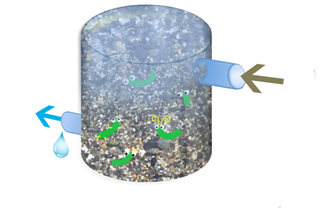Device for purifying liquid wastewater using extended biodiversity
Référence
04502-01
Mots-clés
Statut des brevets
French patent application FR1200091 filed on January 12nd, 2012 entitled « Dispositif d’assainissement d’une eau usée liquide et procédé d’assainissement d’une eau usée liquide mettant en œuvre un tel dispositif. »


Inventeurs
Magali GERINO
Philippe VERVIER
José-Miguel SANCHEZ-PEREZ
Laury GAUTHIER
Statut commercial
Available for exclusive or non-exclusive licenses, Collaborative agreement
Laboratoire
Laboratoire d’écologie fonctionnelle et environnement (ECOLAB) a CNRS laboratory (UMR5245) in Toulouse, France.
Description
CONTEXT
The coupling between ecology and environmental water ingeniering brings new insigh to improve water treatment efficiency. As in natural rivers, more biodiversity helps the system at resisting to perturbation such facing pollutants loads in the water. When biodiversity in the porous matrix is extended to invertebrate detritivorous and predators, therefore the relationships between organisms controls the microbial biomass favors the contact between pollutant and the biofilm. The biodiversity improves the performance of the system in terms of quality of the water, and the addition of invertebrates in current or new water filters provides sustainable solutions to treatment limits.
TECHNICAL DESCRIPTION

The invention relates to a device including: – a container suitable for retaining a granulate consisting of solid particles, and for enabling the liquid wastewater flowing in this container between an inlet and an outlet for substantially decontaminated water to flow out of the container ; a community of microorganisms extending so as to be in contact with the solid particles of the granulate; at least one live benthic invertebrate, with size of greater than 250 µm and at least one live benthic invertebrate, with size between 50 µm and 250 µm and which are distributed in the granulate. The community of macrobenthic organism and meiobenthic organism species includes a proportion of 60% to 80% of invertebrate detrivorous organisms.
BENEFITS
There are numerous advantages of this new process including easy to use, inexpensive and using for great volume. Among the advantage at encreasing biodiversity are the mitigation of sludge production. This new process was tested with succes at reducing loads of refractories pollutants such as pesticides.
INDUSTRIAL APPLICATIONS
Applications include : the treatement of domestic or urban or industrial effuents with organic matter and pesticides. This innovation should get advantage to be used in additional to classical treatement device that need to emprove performance towards emmergeants toxics. This device might also treat 100% of the toxicity of the effluent by itself.
DEVELOPMENT STAGE
The divices was tested in laboratory pilotes made of 100 litres of granulats. The filtering of 800 liters of water with diuron (30 μg/L) during 16 days cancelled the toxicity of the water (mortality of xenope), reduce half of the genotoxicity. In an other test, 150 liters of urbain effuent collected at the inlet of a WWTP reduce the ecotoxicology after 31 days. Nitrate elimination was improved by a factor of 3 in the extended biodiversity device.
For further information, please contact us (Ref 04502-01)
Besoin de plus d'informations ?
Nous contacterTechnologies Liées
-
16.06.2014
Industrial manufacturing of Titanium dioxide macroscopic fibers up to the kilometer
Chimie 06818-01
-
08.04.2014
Novel Design of Cyclic Membrane Gas Separation Process
Chimie 04593-01
-
18.02.2014
Environmentally-friendly processes to breakdown elastomers leading to reusable telechelic oligomers with controlled structures
Chimie 05717-01; 03489-01